David Clayton's Blog, page 20
August 20, 2015
Mass for the Third Anniversary of the Anglican Use Community of St Gregory the Great in Massachusetts, September 3rd
The Anglican Ordinariate community of St Gregory the Great will be have a special Mass for its third Feast of Title and Dedication at St Patrick’s Parish in Stoneham, Massachusetts on September 3rd. It promises to be particularly beautiful, see the poster below or go to their website for more information, www.saintgregoryordinariate.org.
On another but connected note, some readers may remember that I featured the commissioning of chalice and paten by the community which was made in silver. The original article was here. This set has just been given an award by the journal Faith and Form in conjunction with the Interfaith Forum on Religion, Art and Architecture. The designer and maker of the set, silversmith Vincent Hawley will be presented with the award at the May 2016 National Convention of the American Institute of Architects in Philadelphia, PA. His website is www.vwhjewelry.com. Congratulations Vincent!
It is great to see an Anglican Use community flourishing like this!
I’m trying not to think of Danny Kaye…the chalice with the palace has the wine which is fine….:) No sorry, I couldn’t avoid it…
— ♦—
My book the Way of Beauty is available from Angelico Press and Amazon.
—JAY W. RICHARDS, Editor of the Stream and Lecturer at the Business School fo the Catholic University of America said about it: “In The Way of Beauty, David Clayton offers us a mini-liberal arts education. The book is a counter-offensive against a culture that so often seems to have capitulated to a ‘will to ugliness.’ He shows us the power in beauty not just where we might expect it — in the visual arts and music — but in domains as diverse as math, theology, morality, physics, astronomy, cosmology, and liturgy. But more than that, his study of beauty makes clear the connection between liturgy, culture, and evangelization, and offers a way to reinvigorate our commitment to the Good, the True, and the Beautiful in the twenty-first century. I am grateful for this book and hope many will take its lessons to heart.”
Does it really matter what Pixar do? Lighten up, it’s just a children’s movie…
 Thanks to Rick, whoever you are for your comment on the review of Inside Out, posted on August 17th. I responded to it in the comments page, but I think his simple remarks highlight some good discussion points that are worthy of wider consideration. Is the film industry important? Am I just over analyzing an innocent children’s film?
Thanks to Rick, whoever you are for your comment on the review of Inside Out, posted on August 17th. I responded to it in the comments page, but I think his simple remarks highlight some good discussion points that are worthy of wider consideration. Is the film industry important? Am I just over analyzing an innocent children’s film?
 Here is Rick’s comment, he first pulls a quote out of my blogpost:
Here is Rick’s comment, he first pulls a quote out of my blogpost:
‘ “No wonder Riley was struggling with life, she was living in miserable isolation! May the Lord be with your spirit.” Just a thought, you might want to know that Riley is not real. It’s just a movie mate, take it easy. There are bigger battles to fight.’
And here is my reaction. First the quick reply to this is: ‘…And this is just a movie review Rick, and that line you quoted was a joke! Lighten up and take it easy yourself…mate .’
But there is a serious point here and in this I am not joking. In what was an entertaining film (although by Pixar’s high standards I would say only moderately entertaining) is the propagation of a false worldview. How important you think this is depends on how influential you think that such film will be. As a general point I would say that clearly certain parts of the film industry take it very seriously because they go to great lengths to engage the mass population with films that reinforce a false worldview in so many aspects – faith, morals, and attitude to the environment, for example. I would say that they have doing this very very successfully over the last 50 years particularly. This can be done sometimes subtly – as with this film – and sometimes more stridently.
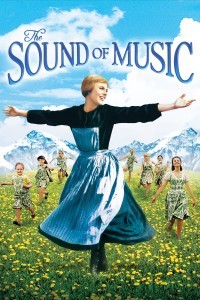 For good or ill, popular culture both reflects and propagates a worldview as powerfully as any essay in an academic journal. If we do not like the wider culture, we cannot disengage from the culture, even if we wanted to. Even the most cloistered monk is product of the greater society of which he is part. The question is not whether or not to engage, therefore, but how do we engage? Are we going to do it well, or badly? How can we transform it so that it becomes one of truth and beauty?
For good or ill, popular culture both reflects and propagates a worldview as powerfully as any essay in an academic journal. If we do not like the wider culture, we cannot disengage from the culture, even if we wanted to. Even the most cloistered monk is product of the greater society of which he is part. The question is not whether or not to engage, therefore, but how do we engage? Are we going to do it well, or badly? How can we transform it so that it becomes one of truth and beauty?
Speaking generally, without having any particular film in mind, the degree of misery and death that results from the propagation of a false psychology, or false morality, or a false environmentalism, or falsity of any form, is immeasurable (I do not exaggerate on this, see my posting on environmentalism next week), and that is what I care about. I am not suggesting that every film is a cynical attempt to manipulate. Very often it is an innocent and well meaning effort to entertain and make money (not bad things in themselves), by appealing to and reflecting the attitudes that it believes its market already has. When the seemingly innocuous presentations are taken to their logical conclusion, however, regardless of motives, the end result is the same in both cases.
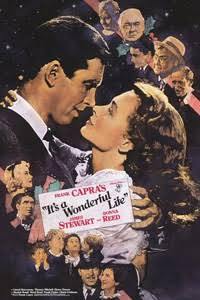 The evangelization of the culture is the battle we must engage in and I would say that there are fewer battles that are more important or bigger.
The evangelization of the culture is the battle we must engage in and I would say that there are fewer battles that are more important or bigger.
Believe it or not, in the 1930s Pius XI praised Hollywood for the influence of the its films on society. However well or badly I am doing it, my motivation in doing a review like this is to try to encourage Christian filmmakers to be involved again and start propagating a worldview that will actually promote the general happiness and harmony in society and ultimately, the salvation of souls. I want to see them engaging as skillfully, as subtly and as engagingly as the secular materialists have been doing in film, music and all aspects of the popular culture. I am not thinking of in-your-face accounts of the gospel, so much as films like Inside Out, which are so engaging that they draw in and influence people without resistance.
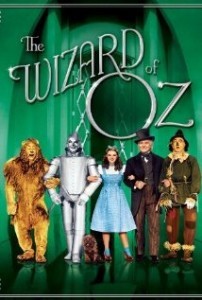 Family films and films for children, incidentally, are an important battleground in this context for two reasons: first, as the Jesuits used to say, give the child and I’ll give you the man. Children are the most easily influenced at will grow up to make future society reflect what they believe. Second, few children watch these movies on their own. There are usually adults with them. One of the ways of making these films so popular is to make them appeal simultaneously at different levels. They are designed to engage the adults too. If the parents are entertained also, then they are more likely to want to take their children to the film. This need to build in a dual appeal means that the genre automatically engages the creators philosophically – they have to be able to think about concepts at different levels; and it is what makes children’s entertainment simultaneously some of the most sophisticated, engaging and powerful there is. At the root of every story are some assumed facts, premises about the nature of reality that govern the logic of the progression of the story and make it either convincing or not as the case may be. This is inescapable. If we ignore this then we risk inadvertently promoting falsity. If we use it, we can create a beautiful, wonderful, entertaining and stimulating culture that influences for the good.
Family films and films for children, incidentally, are an important battleground in this context for two reasons: first, as the Jesuits used to say, give the child and I’ll give you the man. Children are the most easily influenced at will grow up to make future society reflect what they believe. Second, few children watch these movies on their own. There are usually adults with them. One of the ways of making these films so popular is to make them appeal simultaneously at different levels. They are designed to engage the adults too. If the parents are entertained also, then they are more likely to want to take their children to the film. This need to build in a dual appeal means that the genre automatically engages the creators philosophically – they have to be able to think about concepts at different levels; and it is what makes children’s entertainment simultaneously some of the most sophisticated, engaging and powerful there is. At the root of every story are some assumed facts, premises about the nature of reality that govern the logic of the progression of the story and make it either convincing or not as the case may be. This is inescapable. If we ignore this then we risk inadvertently promoting falsity. If we use it, we can create a beautiful, wonderful, entertaining and stimulating culture that influences for the good.
Just to redress the balance, here is a Pixar movie I loved (and, I’m going to admit it, I saw it on my own, as an adult and went to see it twice!).
— ♦—
My book the Way of Beauty is available from Angelico Press and Amazon.
—JAY W. RICHARDS, Editor of the Stream and Lecturer at the Business School fo the Catholic University of America said about it: “In The Way of Beauty, David Clayton offers us a mini-liberal arts education. The book is a counter-offensive against a culture that so often seems to have capitulated to a ‘will to ugliness.’ He shows us the power in beauty not just where we might expect it — in the visual arts and music — but in domains as diverse as math, theology, morality, physics, astronomy, cosmology, and liturgy. But more than that, his study of beauty makes clear the connection between liturgy, culture, and evangelization, and offers a way to reinvigorate our commitment to the Good, the True, and the Beautiful in the twenty-first century. I am grateful for this book and hope many will take its lessons to heart.”
August 19, 2015
Adoremus Bulletin – the July edition is now out. Take a look!
The July edition of the Adoremus Bulletin is now out, produced under the leadership of its new editor Chris Carstens. Articles include translations of public statements by Cardinal George Sarah as well as original articles by Adam Bartlett and Joseph O’Brien.
If you are not yet aware of the great work that Adam Bartlett is doing for chant in the vernacular then you should be!. I only found out recently the full extent of his work. His compositions are published by Illuminare Publications. He is creating excellent chants for the Ordinaries and Propers of the Mass and responsorial psalms available through the Missal, Hymnal and Simple Gradual. Additionally he is composing constantly and four-part arrangements for accompaniment and singing are posted on the Illuminare website score library weekly and are available free of charge until they are published as a collection. These are available to be downloaded free of charge from their . Through the work that he and others are doing,along with others, I think that there is real hope for the establishment of an authentic tradition of chant for English language in the Roman Rite. What he does sits alongside what is happening in the Anglican Ordinariate. One hopes that development in each will nourish the other in the future. I am great believer in the importance of the vernacular in the liturgy alongside – not replacing – the Latin, and among these English is in a uniquely important position at the moment. I have written here in the past of the importance of this not just in liturgical renewal, but also the evangelization of the culture (Has Pope Francis Saved Western Culture?). In his article for Adoremus Bartlett considers the place of hymnody in the Liturgy of the Hours, not only by examining its history but by providing a contemporary context for hymns in the upcoming edition of the Liturgy of the Hours in English.

The second story, by Joseph O’Brien, tells of the newly-dedicated Newman Center church on the campus of the University of Nebraska in Lincoln, and how beauty of the architecture and stained glass windows is intended as a key element in the liturgical formation of college students. While the images in the windows, for example, will communicate and reinforce the truths of the Faith through their content pedagogically, that is not their sole purpose or even their highest purpose. The beauty of the form communicates something that, to paraphrase of the Catechism, words cannot. Content and form combine beautifully in their profoundly thought out liturgical context so as to encourage in the students to a deep and authentic participation in the liturgy. This is the ultimate purpose of beauty in the liturgy. As Chris Cartens points out in his editorial, it is the transfiguration of the students through the worship of God in the Sacred Liturgy as part of the body of Christ that is the ultimate aim of this. One hopes that the new Newman Center in Lincoln will have lasting effect so that many students will go on to be part of a growing body of people who will contribute to the transformation of the whole culture.
August 17, 2015
Film review: Pixar’s Inside Out – watch out, it’s teaching your kids to behave like animals!
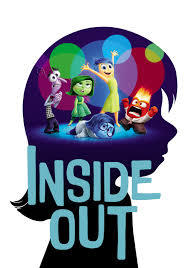 In this animation by Pixar we see how a little girl called Riley copes with a family move from the Midwest to the San Francisco when her father starts a new job. Initially she finds the move difficult and through the film gradually comes to terms with it. The process by which she does so is portrayed as one of conflicting emotions. We look into her mind and see five personifications, of Joy, Fear, Sadness, Disgust and Anger which respond events happening to her as she perceives them, and information fed to her by the subconscious memory. Each battles to be the dominant and so control he mood and actions of Riley.
In this animation by Pixar we see how a little girl called Riley copes with a family move from the Midwest to the San Francisco when her father starts a new job. Initially she finds the move difficult and through the film gradually comes to terms with it. The process by which she does so is portrayed as one of conflicting emotions. We look into her mind and see five personifications, of Joy, Fear, Sadness, Disgust and Anger which respond events happening to her as she perceives them, and information fed to her by the subconscious memory. Each battles to be the dominant and so control he mood and actions of Riley.
The film seems to have been universally well received with most reviewers I have seen give it four or five stars. Although there are some great, funny lines in it, as with all the Pixar offerings I have seen, I did not share this view unreservedly. I thought the story was dull and the imaginary rules by which the competing elements of each emotion responded to the influence of the information seemed inconsistent and so it was unconvincing as an imaginary world inside the mind. You may feel different about that and side with the mainstream reviewers. In the little crowd with whom saw it I was probably the least entertained.
However, I would say that for other reasons, going beyond entertainment, that this is not a film to show your children. I thought it portrayed a flawed anthropology. Read this sentence from the Rotton Tomatoes summary: ‘Like all of us, Riley is guided by her emotions – Joy (Amy Poehler), Fear (Bill Hader), Anger (Lewis Black), Disgust (Mindy Kaling) and Sadness (Phyllis Smith). The emotions live in Headquarters, the control center inside Riley’s mind, where they help advise her through everyday life.’
And therein lies the problem for me. This is a portrayal of the modern obsession with passion and emotion that has been handed on to us from the Romantics of the 19th century and Rousseau in the 18th. In my understanding (supported by my own experience, even as an eleven year old), we are not all subject to our emotions in the way that the reviewer supposes and film makers want us to believe. We have reason, we have a will. We assess all the information and although we might choose to do sometimes, we are not bound to follow the dictates whichever emotion is the strongest. That puts us at the level of animals.
There is something important missing in Inside Out. There is a part of the soul that can make judgments and which, in some way, steps back from our instinctive reactions to things and influence of the memories. It observes all the information coming into the mind and then decides what to do. This the spirit. The spirit ican look to others in love and it is by the spirit that we relate to others and to God as a human person, (just as the persons of the Trinity relate to each other). This is what is special to man among creatures: he is able to observe himself. I once heard it put like this. Animals are aware of things, like man; but unlike man they are not aware that they are aware.
Pope Benedict XVI (as Cardinal Ratzinger) wrote about the spirit as the aspect of the soul by which we relate to other in an essay for the journal Communio published in 1990 (p 439, Communio 17, Fall 1990). In reference to the spirit he wrote: ‘It is the nature  of the spirit to put itself in relation, the capacity to see itself and the other…the spirit is not merely there, it goes back on itself, as it were; it knows about itself. It constitutes a double existence which not only is, but knows about itself, has itself.’ In icons, you often see faces portrayed with a slight lump or dimple in the middle of the forehead just above the bridge of the nose. This can be thought of as a symbol of the spirit. My teacher would refer to it with the Greek term, the nous, (meaning literally ‘mind’) and call it the the ‘spiritual eye’.
of the spirit to put itself in relation, the capacity to see itself and the other…the spirit is not merely there, it goes back on itself, as it were; it knows about itself. It constitutes a double existence which not only is, but knows about itself, has itself.’ In icons, you often see faces portrayed with a slight lump or dimple in the middle of the forehead just above the bridge of the nose. This can be thought of as a symbol of the spirit. My teacher would refer to it with the Greek term, the nous, (meaning literally ‘mind’) and call it the the ‘spiritual eye’.
This is the spirit which is referred to by St Paul in Thessalonians, and by the writer of the letter to the Hebrews. It is referred to by Our Lady in the Magnificat, which is sung in Vespers every day, when she says: ‘My spirit rejoices in God my saviour.’ In the Mass, the priest turns to us and says, ‘The Lord be with you.’ And we reply, ‘And with your spirit.’ In both cases the spirit is instrumental in being in relationship with God.
Christian commentators can differ on precisely which aspects of soul reside in the spirit, but St Thomas, for example, says that it is the intellect and the will, by which we know and love, constitute the spirit. It is the spirit, he says, that separates man from ‘brute animals’ and likens us to angels. (I wrote a longer article on this anthropology, here.)
This is the great problem with Inside Out, in the child Riley there is no sixth personification. This sixth aspect of the soul should have been there, detached from the emotions and able to reason and to love and be open to the promptings of grace and the Holy Spirit.
No wonder Riley was struggling with life, she was living in miserable isolation! May the Lord be with your spirit.
August 14, 2015
Divine Wisdom, Maximilian Kolbe, Thomas More College of Liberal Arts and Mundelein Seminary’s Chapel for the New Evangelization
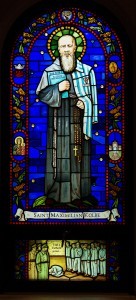 Love of God in the Sacred Liturgy – this is the source of Divine Wisdom and the goal of a good education…for lay people and seminarians alike.
Love of God in the Sacred Liturgy – this is the source of Divine Wisdom and the goal of a good education…for lay people and seminarians alike.
Today, 14th August, is the commemoration of St Maximilian Kolbe. When I read through the account of his life given in Universalis most of it surprised me. I was aware of his heroic martyrdom in Auschwitz. What I hadn’t realized was the extent of his achievements prior to this. Here was a Franciscan friar who was tirelessly following his mission of evangelization in Europe and in Japan; he founded a sodality that attracted great many devotees to Our Lady and even a community which became a ‘Marian city’ that attracted many lay people and published books and journals that were read widely. Here is man who not only found his ‘vocation’ (in the tradition sense of the word) so that he became a religious in the Franciscan order; but also in the broader sense in that he found his personal vocation. Clearly he had a special charism. He found out what it was and he understood how to direct it so that all these initiatives grew up around him.
And here is the amazing fact. Every single one of us has a personal vocation by which we flourish and complete the work of God. Sometimes the effects will be visible, as with St Maximilian, and sometimes veiled and perhaps only visible in time. But always the effect is a dramatic in the divine economy and is as profound as that which allowed St Maximilian to volunteer himself for execution in order to save the life of a fellow prisoner. This is the Christian life: centered on the love of God in the Sacred Liturgy by which we are transfigured so that we can love man so profoundly, and in accordance with our own calling, create a culture of beauty around us.
A true Christian education is a formation that directs us to this supernatural end so that all we do in this life is done in accord with the divine will. The book, the Way of Beauty, recently published by Angelico Press, describes this formation and this is taught at Thomas More College of Liberal arts as part of the curriculum, where I am a Fellow. The book, the Little Oratory – a Beginner’s Guide to Praying in the Home, describes a pattern of worship and prayer by which this is possible if we participate freely in it.
St Maximilian Kolbe understood that the power and the insight that we are given goes beyond what is otherwise humanly possible. It is divine. We become ‘vice-gerents’ – earthly representatives of God (I had to look up the meaning for this article in case your wondering – one aspect of wisdom which was not conveyed supernaturally to me!). Here is an excerpt from today’s Office of Readings in which he describes it:
‘God himself is the one infinite, wise, holy, and merciful Lord, our Creator and our Father, the beginning and the end, wisdom, power, and love – God is all these. Anything that is apart from God has value only in so far as it is brought back to him, the Founder of all things, the Redeemer of mankind, the final end of all creation. Thus he himself makes his holy will known to us through his vice-gerents on Earth and draws us to himself, and through us – for so he has willed – draws other souls too, and unites them to himself with an ever more perfect love. See then, brother, the tremendous honour of the position that God in his kindness has placed us in. Through obedience we transcend our own limitations and align ourselves with God’s will, which, with infinite wisdom and prudence, guides us to do what is best. Moreover, as we become filled with the divine will, which no created thing can resist, so we become stronger than all others.’
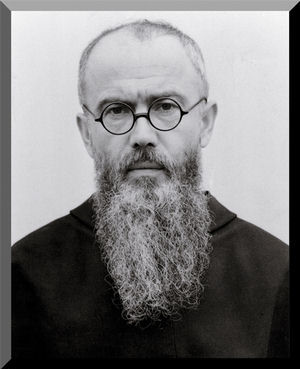
Incidentally, the image shown is one of the beautiful stained glass windows from the recently completed John Paul II chapel at the Mundelein Seminary in Chicago (an educational institution!). The chapel is the inspiration of the rector of the seminary, Fr Robert Barron (perhaps already ‘former rector’, he was recently named as auxiliary bishop for Los Angeles archdiocese). The page from the blog of the company that made the window (as part of a whole series in the chapel) explains that Fr. Barron envisioned the chapel to ‘serve as an inspiration to generations of seminarians and a physical embodiment of the New Evangelization’.
Fr Barron and the architectural historian and sacred art expert Denis McNamara (who teaches at the Liturgical Institute at Mundelein) ensured that the symbolism of the imagery was in full accord with Christian tradition and fully liturgical. If these fulfill their function they they will engender in the worship of those seminarians undergoing their priestly education a deeper participation in the sacred liturgy that will lead them to that supernatural transformation in Christ; so forming them as agents of the New Evangelization who are, in turn, capable of transfiguring the whole culture. One hopes that this focus on the centrality of the sacred liturgy in the life of man will continue at the seminary for years to come even with the departure of Fr Barron.
There are strong connections to the saint in this northern suburb of Chicago. The Franciscan friars of Marytown church which is next to the seminary are custodians to the US national shrine to St Maximilian!
Divine Wisdom, Maximilian Kolbe, Thomas More College of Liberal Arts and Fr Barron’s Chapel for the New Evangelization
 Love of God in the Sacred Liturgy – this is the source of Divine Wisdom and the goal of a good education…for lay people and seminarians alike.
Love of God in the Sacred Liturgy – this is the source of Divine Wisdom and the goal of a good education…for lay people and seminarians alike.
Today, 14th August, is the commemoration of St Maximilian Kolbe. When I read through the account of his life given in Universalis most of it surprised me. I was aware of his heroic martyrdom in Auschwitz. What I hadn’t realized was the extent of his achievements prior to this. Here was a Franciscan friar who was tirelessly following his mission of evangelization in Europe and in Japan; he founded a sodality that attracted great many devotees to Our Lady and even a community which became a ‘Marian city’ that attracted many lay people and published books and journals that were read widely. Here is man who not only found his ‘vocation’ (in the tradition sense of the word) so that he became a religious in the Franciscan order; but also in the broader sense in that he found his personal vocation. Clearly he had a special charism. He found out what it was and he understood how to direct it so that all these initiatives grew up around him.
And here is the amazing fact. Every single one of us has a personal vocation by which we flourish and complete the work of God. Sometimes the effects will be visible, as with St Maximilian, and sometimes veiled and perhaps only visible in time. But always the effect is a dramatic in the divine economy and is as profound as that which allowed St Maximilian to volunteer himself for execution in order to save the life of a fellow prisoner. This is the Christian life: centered on the love of God in the Sacred Liturgy by which we are transfigured so that we can love man so profoundly, and in accordance with our own calling, create a culture of beauty around us.
A true Christian education is a formation that directs us to this supernatural end so that all we do in this life is done in accord with the divine will. The book, the Way of Beauty, recently published by Angelico Press, describes this formation and this is taught at Thomas More College of Liberal arts as part of the curriculum, where I am a Fellow. The book, the Little Oratory – a Beginner’s Guide to Praying in the Home, describes a pattern of worship and prayer by which this is possible if we participate freely in it.
St Maximilian Kolbe understood that the power and the insight that we are given goes beyond what is otherwise humanly possible. It is divine. We become ‘vice-gerents’ – earthly representatives of God (I had to look up the meaning for this article in case your wondering – one aspect of wisdom which was not conveyed supernaturally to me!). Here is an excerpt from today’s Office of Readings in which he describes it:
‘God himself is the one infinite, wise, holy, and merciful Lord, our Creator and our Father, the beginning and the end, wisdom, power, and love – God is all these. Anything that is apart from God has value only in so far as it is brought back to him, the Founder of all things, the Redeemer of mankind, the final end of all creation. Thus he himself makes his holy will known to us through his vice-gerents on Earth and draws us to himself, and through us – for so he has willed – draws other souls too, and unites them to himself with an ever more perfect love. See then, brother, the tremendous honour of the position that God in his kindness has placed us in. Through obedience we transcend our own limitations and align ourselves with God’s will, which, with infinite wisdom and prudence, guides us to do what is best. Moreover, as we become filled with the divine will, which no created thing can resist, so we become stronger than all others.’

Incidentally, the image shown is one of the beautiful stained glass windows from the recently completed John Paul II chapel at the Mundelein Seminary in Chicago (an educational institution!). The chapel is the inspiration of the rector of the seminary, Fr Robert Barron (perhaps already ‘former rector’, he was recently named as auxiliary bishop for Los Angeles archdiocese). The page from the blog of the company that made the window (as part of a whole series in the chapel) explains that Fr. Barron envisioned the chapel to ‘serve as an inspiration to generations of seminarians and a physical embodiment of the New Evangelization’.
Fr Barron and the architectural historian and sacred art expert Denis McNamara (who teaches at the Liturgical Institute at Mundelein) ensured that the symbolism of the imagery was in full accord with Christian tradition and fully liturgical. If these fulfill their function they they will engender in the worship of those seminarians undergoing their priestly education a deeper participation in the sacred liturgy that will lead them to that supernatural transformation in Christ; so forming them as agents of the New Evangelization who are, in turn, capable of transfiguring the whole culture. One hopes that this focus on the centrality of the sacred liturgy in the life of man will continue at the seminary for years to come even with the departure of Fr Barron.
There are strong connections to the saint in this northern suburb of Chicago. The Franciscan friars of Marytown church which is next to the seminary are custodians to the US national shrine to St Maximilian!
August 13, 2015
How the Entrepreneur Creates a Beautiful Culture; and the Beautiful Culture Engenders Entrepreneurial Activity
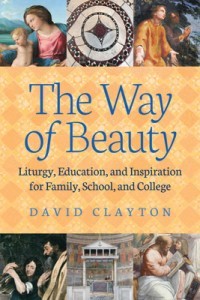 And why being an entrepreneur is a vocation and a responsibility.
And why being an entrepreneur is a vocation and a responsibility.
How can we change society and the culture into one that is beautiful, is just and is built on true community? I say, that if we wish to change society we look to ourselves first so that we become the people who are transformed in Christ and show him to others by our actions and interactions. Society is network of personal interactions, and we change society, therefore by changing the way we interact with others.
Only God’s grace can do this for us, and it is by prayer, or more precisely, by worship of God that we encounter Christ in such a way that it can happen. When we can be one of those people, then people will be drawn to the Church through us and join us. To the degree that anyone is participating in the divine nature and showing people the transfigured Christ in their daily lives, he is someone who, by grace, will relate to others in properly ordered love. This is what attracts people to the faith. All economic interactions ought to be personal and loving as much as any other in a good society. In the sphere of economics this is how the principle of superabundance is invoked that creates prosperity for society. This is the secret for the creation for wealth.
This applies to all of us for we are all involved in economic interactions of some sort and we all need to flourish and make sufficient wealth to live on. However, some people have a particular calling to be entrepreneurs. They have a special grace, an ability to make money beyond their personal needs and in a way that encourages human flourishing at all levels. However, for that calling to be realized, they need also to be aware of not only how to make money in a way that is in accord with the common good, but also, the end to which that money should be directed responsibly. They must be good stewards. It is the nature of charisms that unless they are directed in love, they evapourate, ie they cannot be misused. So while it is possible for someone to make money selfishly, or course, and also for people who do not have this particular calling to develop the skill of entrepeneurship and be driven by good motives. The person who has this charism, however, and special calling, will generate wealth almost effortlessly (compared to others) and in great abundance when does so in accordance with the principle of love.
Benedict XVI describes this ideal for personal interactions in economic activity in his encyclical, Caritas in veritate. It is a network of such personal interactions that in aggregate form a free society and the free economy described by John Paul II in Centesimus annus.
Benedict describes how Christians are transformed in Christ in this life by degrees and by grace – transfigured and participating in the divine nature – through a personal encounter with God in the Eucharist. To the degree that human relationships are driven by concern for the other person, they are in accordance with the Trinitarian dynamic of love that is the model for the loving component of personal relationships. When this Love is present it is always superabundant. Love is superabundant - fruitful without measure – because of the generosity of God who can give beyond all limitations and creates out of nothing. It is by this principle that wealth is generated in properly ordered economic transactions.
Though we may not think of it as such, the ordinary exchange of goods for money that we are daily engaged in does not redistribute wealth, it creates wealth. By this simple exchange both parties have something they value more than before and so wealth has been created (otherwise they would not both choose to make the exchange). There is a caveat. This is true provided that there is personal freedom (understood not simply as lack of constraint, but also full knowledge of the practicable best).
One of the beauties of the free market is that if I am dealing with someone in such a transaction who is genuinely free to choose whether or not he trades with me, then even if I am driven by selfish ends I am forced to consider his needs and what is good from his point of view. If I don’t then the chances are that he will choose not to trade with me because he is free not to do so. So provided that freedom is present, even the selfish like me are forced to some degree at least into loving action. Even in this minimal form of love there is superabundance. In practice, rarely is someone wholly driven by selfish interests, just as rarely is someone wholly loving in action and thought. Superabundance is maximized to the degree that both parties are genuinely interested in the well being of the other as they engage in the transaction. This is when all the aspects for which a price cannot be paid – at a simple level a genuine care and attention, for example are given freely too. To the degree that the loving component grows then people relate to each other so that the other flourishes. When the conditions exist that allow for this to happen, people will naturally seek out others who interact in this way and the complexion of the economy gradually changes. Economic prosperity is maximized to the extent that the activity that creates it is in harmony with a flourishing of the society of human persons. When people are transformed in Christ, then they are more naturally inclined to consider the other in what they do and go beyond the simple contractual elements of trade, and create an economy that is rooted in a love which goes beyond the minimum requirement of justice.
One might refer to this as a covanental economy, one that is ordered to mutual giving, rather than one that is purely contractual and relies on the alignment of self-interest alone.
John Paul II pointed out in Centesimus annus that the market is the most efficient and best way to distribute goods for which a price can be paid. He then stated that this also defines the limitations of the market, it cannot distribute those things for which a price cannot be paid which are also vital in life and the flourishing of the human person. Benedict in Caritas in Veritate connects the two much more directly in each economic transaction and says that unless those aspects for which money is not paid are present there too, he calls this additional element one of gratuitousness - then there is no superabundance. In fact he goes on to say that gratuitousness must be present if wealth is to be created.
When freedom is lacking – as it would be even in an otherwise free society in the case of an addict buying illegal drugs for example, the result is not the superabundant creation of wealth, but an enforced redistribution of wealth that favors one party more than the other inequitably. The party that gains is not just taking advantage of the other person in the exchange, but is parasitical upon society as a whole , drawing from it, rather than contributing to it; one only needs to look at a neighborhood in which drug dealing is rife to see the effects. Similarly, government taxation directed towards paying for activities that go beyond the natural role of government (which should be limited to the regulating for and protecting personal freedom) are also acts against the common good that go against freedom, are contrary to what a government’s role should be and will have the stultifying effects on society as whole that we see in Venezuela today and saw in the Eastern bloc countries of the past so markedly.
Benedict describes how the personal transformation, by which a person is capable and inclined to interact lovingly with his neighbors, will occur. It is through prayer: a liturgically centered piety . Not all prosperous societies are Catholic societies (whatever we mean by that) and not all Catholic societies are prosperous. But it is to the degree that any earthly city and its people participate in those ideals of the City of God, Catholic or not, that it is prosperous and stable.
It is the beauty of the culture, and especially the culture of Faith that will inspire Christians to pray well, and non-believers to pray at all. Beauty engenders creativity, inspires to love and so to participate in superabundant love in anything we do, including trade. This is why beauty and economics are inseparable.
The book, the Way of Beauty is a manual for a formation in beauty that explains how the whole culture is a reflection of divine love, how we can become agents of that change, and how educators can form others too.
July 31, 2015
The Way of Beauty – a book to inspire the transfiguration of our culture
 How to be part of the New Evangelization – for educators and for all who are interested in a formation in beauty; and for those who want to contribute creatively to a culture of beauty and abundance – teachers, artists, entrepreneurs, parents…
How to be part of the New Evangelization – for educators and for all who are interested in a formation in beauty; and for those who want to contribute creatively to a culture of beauty and abundance – teachers, artists, entrepreneurs, parents…I am pleased that my book, the Way of Beauty – Liturgy, Education and Inspiration for Family, School and College is now out and available from Angelico Press. This is one of the projects I have been working over the summer. All the others are connected to the promotion of a ‘new epiphany of beauty’ in the modern era. I will now start to talk about these as we go forward.
In the book, I describe how a true Catholic education is both a program of liturgical formation and an inculturation that aims for the supernatural transformation of the person so that he can in turn transfigure the whole culture through the divine beauty of his daily action. As Pope Benedict has told us, there is no human activity, no matter how 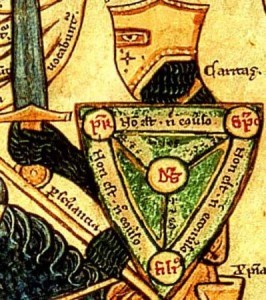 mundane, that cannot be enhanced by this formation in beauty. Such enhanced activity then resonates in harmony with the common good and, through its beauty, draws all people to the Church — and ultimately to the worship of God in the Sacred Liturgy.
mundane, that cannot be enhanced by this formation in beauty. Such enhanced activity then resonates in harmony with the common good and, through its beauty, draws all people to the Church — and ultimately to the worship of God in the Sacred Liturgy.
The Way of Beauty will be of profound interest not only to artists, architects, and composers, but also to educators, who can apply its principles in home and classroom for the formation and education of children and students of all ages and at all levels — family, homeschooling, high school, college, and university. You can order from the Angelico Press website here
Praise for the Way of Beauty:
“Since the good, the true, and the beautiful are a manifestation of the Trinity, it is always a grievous fault to leave beauty out of any discussion of the relationship between faith and reason. This being so, I am thrilled at the way David Clayton illustrates how beauty stands in eternal communion with the good and the true.”
—JOSEPH PEARCE, Aquinas College

“In spite of the great proclamation that the sacred liturgy is the font and apex of all we are about as Catholics, fifty years after the Council we still seem far from seeing and living this truth in all its fullness. Drawing upon years of experience as artist and teacher, David Clayton thoroughly unpacks this truth and shows, with an impressive range of examples, how it can and should play out every day in our schools, academic curricula, cultural endeavors, and practice of the fine arts. His treatment of the ways in which architecture, liturgy, and music reflect the mathematical ordering of the cosmos and the hierarchy of created being is illuminating and exciting. The Way of Beauty is a manifesto for the re-integration of the truth laid hold of in intellectual disciplines, the beauty aspired to in art and worship, and the good embodied in morals and manners. Ambitiously integrative yet highly practical, this book ought to be in the hands of every Catholic educator, pastor, and artist.”
—PETER KWASNIEWSKI, Wyoming Catholic College and writer for the New Liturgical Movement
Order here

“In The Way of Beauty, David Clayton offers us a mini-liberal arts education. The book is a counter-offensive against a culture that so often seems to have capitulated to a ‘will to ugliness.’ He shows us the power in beauty not just where we might expect it — in the visual arts and music — but in domains as diverse as math, theology, morality, physics, astronomy, cosmology, and liturgy. But more than that, his study of beauty makes clear the connection between liturgy, culture, and evangelization, and offers a way to reinvigorate our commitment to the Good, the True, and the Beautiful in the twenty-first century. I am grateful for this book and hope many will take its lessons to heart.”
—JAY W. RICHARDS, Catholic University of America and Editor of The Stream.
Order here

“David Clayton has written an inspirational and thought-provoking book about the connections among faith, education, culture, and art. As a parent whose two daughters attend Catholic school, I found his work on formation, education, and the liturgy very interesting. As an academic, I am impressed with the research and intellectual rigor. Clayton has made an important contribution to the Catholic faith community with this book.”
—MICHAEL ROBERTO, Professor of Management, Bryant University
“Every pope who has promoted the new evangelization has spoken about how essential ‘the way of beauty’ is in engaging the modern world with the Gospel. What is it about the experience of beauty that can arrest the heart, crack it open, and stir its deepest longings, leading us on a pilgrimage to God? David Clayton’s book provides compelling answers.”
—CHRISTOPHER WEST, Founder and President of The Cor Project

“David Clayton has written a wonderful new book that highlights the centrality of beauty and art in education and human formation. He explains the deep relationship between liturgy and culture, while offering practical ways to educate a new generation of artists who can bring about what St. John Paul called a ‘new epiphany of beauty.’”
—MICHAEL MATHESON MILLER, Acton Institute, writer and presentor of PovertyCure
Order here

Order here
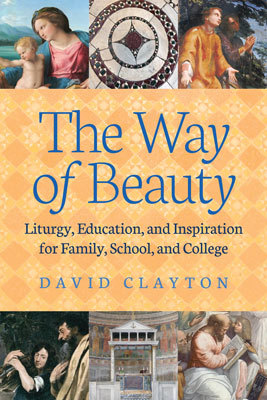
July 28, 2015
Should We Paint God the Father?
 One of the most famous pieces of sacred art that exists is Michelangelo’s fresco, in the Sistine Chapel, of God giving the spark of life to Adam. Despite its popularity and familiarity, I had often wondered about the validity of representing God the Father.
One of the most famous pieces of sacred art that exists is Michelangelo’s fresco, in the Sistine Chapel, of God giving the spark of life to Adam. Despite its popularity and familiarity, I had often wondered about the validity of representing God the Father.
My own instincts run against the idea of portraying God the Father in a painting at all, even when I was a child (I always thought that the white-whiskered God looked more like God the Grandfather, than God the Father). Later on in life, this was reinforced by the fact that my icon painting training led me to believe that it was wrong. I was pretty sure, but not certain, that it was not part of the tradition. Certainly, I have never painted an icon of God the Father. Furthermore, the theology of Theodore the Studite in regard to sacred imagery, which is accepted by both Eastern and Western Churches, bases the argument for the creation of any figurative art upon the fact that we can portray the person of Christ as man. The person of God the Father is a spiritual being and most certainly not man. This would seem to suggest that we should not portray the Father as man either.
 I quietly suspected that the white-bearded God of Michelangelo or William Blake or even my favourite baroque artist Velazquez were all in error, his Crowning of the Virgin by the Trinity is to the right. I wasn’t too worried about Blake, an eccentric non-Catholic, but Michelangelo and Velazquez?
I quietly suspected that the white-bearded God of Michelangelo or William Blake or even my favourite baroque artist Velazquez were all in error, his Crowning of the Virgin by the Trinity is to the right. I wasn’t too worried about Blake, an eccentric non-Catholic, but Michelangelo and Velazquez?
I was approached recently to do a commission that involves the portrayal of the Father. Rather than reject it out of hand, I thought I had better find out where the Church stands on this.
Here’s what my first investigations have revealed. For the first thousand years or so of Christianity, East and West, there was little portrayal of the Father figuratively. Then images started to appear in both the Eastern and Western traditions, though it was more common in the West.
There are two simple arguments that I have found for the representation of the Father: the first is that Christ said in John 14:9 that whoever has seen me has seen the Father. This would seem to open up to a representation of the Father as the Son. So, one could say, seeing an image of the Sacred Heart of Jesus is also seeing one of the Sacred Heart of the Father, with the heart of the Father understood as a symbol of His love.
 The second is that the white-bearded figure, which we are all familiar with is the Ancient of Days in the book of Daniel (7:9, 13, 22). This is the source of so many familiar portrayals of the Father. In the East there is a tradition known as the New Testament Trinity. This title would distinguish it from the Hospitality of Abraham (in which three angelic strangers represent the three persons of the Trinity). Right is a Greek Orthodox New Testament Trinity from the ceiling of the entrance Vatopedion Monastery at Agion Oros (Mount Athos), Greece. The Catholic Church, allows for the interpretation of the Ancient of Days as the Father, which justifies the portrayal of the Father. (I have been told that Pope Benedict XIV [fourteenth, not sixteenth!] in 1745 pronounced this, though beyond a Wikipedia reference I have not been able to validate this). It also allows for the interpretation of the Ancient of Days as Christ. The Russian Orthodox Church, since the synod of Moscow in 1667 has forbidden the portrayal of God the Father as a man. Consistent with this it interprets the Ancient of Days strictly as the Son. It is this decision of the pronouncement by the Russian church that gave me the idea, wrongly, that it had never been part of the Eastern tradition and that the whole present Eastern Church forbids it.
The second is that the white-bearded figure, which we are all familiar with is the Ancient of Days in the book of Daniel (7:9, 13, 22). This is the source of so many familiar portrayals of the Father. In the East there is a tradition known as the New Testament Trinity. This title would distinguish it from the Hospitality of Abraham (in which three angelic strangers represent the three persons of the Trinity). Right is a Greek Orthodox New Testament Trinity from the ceiling of the entrance Vatopedion Monastery at Agion Oros (Mount Athos), Greece. The Catholic Church, allows for the interpretation of the Ancient of Days as the Father, which justifies the portrayal of the Father. (I have been told that Pope Benedict XIV [fourteenth, not sixteenth!] in 1745 pronounced this, though beyond a Wikipedia reference I have not been able to validate this). It also allows for the interpretation of the Ancient of Days as Christ. The Russian Orthodox Church, since the synod of Moscow in 1667 has forbidden the portrayal of God the Father as a man. Consistent with this it interprets the Ancient of Days strictly as the Son. It is this decision of the pronouncement by the Russian church that gave me the idea, wrongly, that it had never been part of the Eastern tradition and that the whole present Eastern Church forbids it.
 There is a Western tradition of portrayal of the trinity in a type known as the Throne of Mercy, in which the Father sits on his throne and presents his crucified son to the viewer while a dove rests on the cross or hovers just above it. It was this that was explicitly mentioned by Benedict XIV. A 16th century German version is shown left. This tradition goes right back the Medieval times in the Western Church and we have this continued even into the 20th century with Eric Gill in England doing woodcut of this image in a modern gothic style.
There is a Western tradition of portrayal of the trinity in a type known as the Throne of Mercy, in which the Father sits on his throne and presents his crucified son to the viewer while a dove rests on the cross or hovers just above it. It was this that was explicitly mentioned by Benedict XIV. A 16th century German version is shown left. This tradition goes right back the Medieval times in the Western Church and we have this continued even into the 20th century with Eric Gill in England doing woodcut of this image in a modern gothic style.
So where do I stand on this now? Clearly the portrayal of the Father as a grey-haired man is permitted. I would feel on safest ground following the traditional presentations, such as the Mercy Throne image. Outside that, I would be consider images, but would be cautious, unwilling to promote, as Caroline Farey of the School of the Annunciation put it to me, ‘any trend of anthropomorphizing God the Father in case the transcendence of God is further compromised in people’s imaginations.’
It is worth pointing out also, that when God is portrayed as a single person in the form of the Ancient of Days, we cannot be sure that it is the Father who is portrayed. The artist might, quite justifiably, have the intention of representing the Son. I have not, for example, been able to find an authoritative text that tells us precisely which person of the Trinity either Michelangelo or Blake intended us to be looking at (I would welcome comments from readers on this point).
Below: an early gothic Mercy Throne; a 20th century version by the Englishman, Eric Gill; an early gothic pieta in which God the Father supports the son; a baroque Mercy Throne by Ribera, 17th century; and William Blake’s Ancient of Days.
July 21, 2015
Don’t Beat About the Bush…Change the Culture! More on Land and the Common Good
 Landowners have a duty to leave some food for the poor and give people access to get it. Or that’s what it looks like at least. Here are two scriptural passages taken from the Office of Readings (part of the Liturgy of the Hours) that caught my eye when I read them. One is from January and the other is a Lenten reading. Office of Readings 24th Jan 2011, Commemoration of St Francis de Sales: “You must not pervert justice in dealing with a stranger or an orphan, nor take a widow’s garment in pledge. Remember that you were a slave in Egypt and that the Lord your God redeemed you from there. That is why I lay this charge on you. When reaping the harvest in your field, if you have overlooked a sheaf in that field, do not go back for it. Leave it for the stranger, the orphan and the widow, so that the Lord your God may bless you in all your undertakings. When you beat your olive trees you must not go over the branches twice. Let anything left be for the stranger, the orphan and the widow. When you harvest your vineyard you must not pick it over a second time. Let anything left be for the stranger, the orphan and the widow. Remember that you were a slave in the land of Egypt. That is why I lay this charge on you.” (Dueteronomy 24) And Tuesday 4th week of Lent “When you gather the harvest of your land, you are not to harvest to the very end of the field. You are not to gather the gleanings of the harvest. You are neither to strip your vine bare nor to collect the fruit that has fallen in your vineyard. You must leave them for the poor and the stranger. I am the Lord your God.(Leviticus 19) I have written on a number of occasions, here, that land is considered by the Church a common good. This means that like air and food it is something that should be available to all people. This does not mean that there should not be private property however, provided that private ownership of property is viewed as an entitlement to work the land. This privilege of ownership brings obligations. Its use should be for the benefit of the common good. This is not so completely counter cultural as it might sound at first. Generally, growing crops on a farm; and then selling anything (beyond what is needed for personal consumption) for distribution through the market is in accord with this. This entitlement, however, and this part might be counter cultural in some parts of the world, is not always seen as extending to allowing the owner to exclude others from his land all the time, as the quoted passages above indicate.
Landowners have a duty to leave some food for the poor and give people access to get it. Or that’s what it looks like at least. Here are two scriptural passages taken from the Office of Readings (part of the Liturgy of the Hours) that caught my eye when I read them. One is from January and the other is a Lenten reading. Office of Readings 24th Jan 2011, Commemoration of St Francis de Sales: “You must not pervert justice in dealing with a stranger or an orphan, nor take a widow’s garment in pledge. Remember that you were a slave in Egypt and that the Lord your God redeemed you from there. That is why I lay this charge on you. When reaping the harvest in your field, if you have overlooked a sheaf in that field, do not go back for it. Leave it for the stranger, the orphan and the widow, so that the Lord your God may bless you in all your undertakings. When you beat your olive trees you must not go over the branches twice. Let anything left be for the stranger, the orphan and the widow. When you harvest your vineyard you must not pick it over a second time. Let anything left be for the stranger, the orphan and the widow. Remember that you were a slave in the land of Egypt. That is why I lay this charge on you.” (Dueteronomy 24) And Tuesday 4th week of Lent “When you gather the harvest of your land, you are not to harvest to the very end of the field. You are not to gather the gleanings of the harvest. You are neither to strip your vine bare nor to collect the fruit that has fallen in your vineyard. You must leave them for the poor and the stranger. I am the Lord your God.(Leviticus 19) I have written on a number of occasions, here, that land is considered by the Church a common good. This means that like air and food it is something that should be available to all people. This does not mean that there should not be private property however, provided that private ownership of property is viewed as an entitlement to work the land. This privilege of ownership brings obligations. Its use should be for the benefit of the common good. This is not so completely counter cultural as it might sound at first. Generally, growing crops on a farm; and then selling anything (beyond what is needed for personal consumption) for distribution through the market is in accord with this. This entitlement, however, and this part might be counter cultural in some parts of the world, is not always seen as extending to allowing the owner to exclude others from his land all the time, as the quoted passages above indicate.
In a number of European countries (I know of England, Scotland, Spain and Italy specifically) there is public right of way preserved in law, on privately owned land. This is a tradition that goes back to medieval times. While the landowner is obliged to allow people on his land, those who go onto the land are also obliged to respect the property and the crops that are growing respecting it’s function as contributing to the common good. I don’t know if any applications of this extend to being in accord with the passages from the bible, which clearly allow for “the stranger, the orphan and the widow” to go onto the land and gather food.
There is an American version of this approach, as I understand it whereby in some states the default situation is that people do have access to private land to hunt. In New Hampshire there is an option to pay a higher land tax and that allows you then to bar everyone else from your land. I wouldn’t be interested in hunting, just the chance of finding a walkable path across farmland. I did find one farm west of Nashua, NH when I was living there that had a notice saying. Please do come an enjoy our farm land but we ask that you respect it. I don’t know if it was a coincidence, but the was a large statue of he Virgin Mary very visible next to the farmhouse as we walk off the land.
It seems that perhaps the Fathers of the Second Vatican Council and those subsequently who actually revised the Office of Readings considered this an important principle for today; otherwise it would not have been included in regular readings in the Church’s liturgy. I believe that access to the land is important even for those who are not so poor that they need to pick the crops for personal use. It is important for the soul, I think. And this means access to cultivated land, productive land, not the wilderness. It is good to have firsthand experience of man’s productive and harmonious activities with nature. This shapes not only the view of nature, but the view of man’s proper relationship with the land.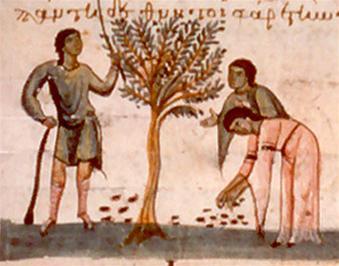 This access will also, I believe raise people’s wonder at the beauty of cultivated land (whether ornamental garden or agricultural) and so perhaps help to offset the neopaganism that gives rise ultimately to the culture of death. When the only country landscape available to man is wilderness, and all else he sees is modern suburbia or a cityscape, then it reinforces the idea that the standard of beauty is that land which is untouched by man, that is wilderness. This in turn reinforces the idea that man’s influence on nature is always detrimental and the natural extension of this idea is profound evil: the most effective way to restrict man’s bad influence on nature, so the logic runs, is to restrict his activity through population control, which means contraception, abortion and euthanasia.
This access will also, I believe raise people’s wonder at the beauty of cultivated land (whether ornamental garden or agricultural) and so perhaps help to offset the neopaganism that gives rise ultimately to the culture of death. When the only country landscape available to man is wilderness, and all else he sees is modern suburbia or a cityscape, then it reinforces the idea that the standard of beauty is that land which is untouched by man, that is wilderness. This in turn reinforces the idea that man’s influence on nature is always detrimental and the natural extension of this idea is profound evil: the most effective way to restrict man’s bad influence on nature, so the logic runs, is to restrict his activity through population control, which means contraception, abortion and euthanasia.
I do not believe that this alone will reverse the culture of death (abortion exists in Europe too). However, if any discussion of these ideas in both Europe and the New World is combined with the example of what people see if they have access to cultivated land it will, I feel, speak of man’s positive impact on the natural world. This then could help to change views on man’s relationship with Creation. The change will not occur through engagement in discussion, so much as through a subtle influence that seeps into the thinking of society. Then perhaps, in some small way at least, it could contribute to the transformation a culture in the reverse direction to what is happening now and which is so anti-human.
So it seems that the dictum, spare the rod and spoil the child doesn’t extend to olive trees! The photograph below of the Tuscan countryside. Above that we have Spanish olive groves and an illumination from Crete dating from the Byzantine rule.

David Clayton's Blog
- David Clayton's profile
- 4 followers



















